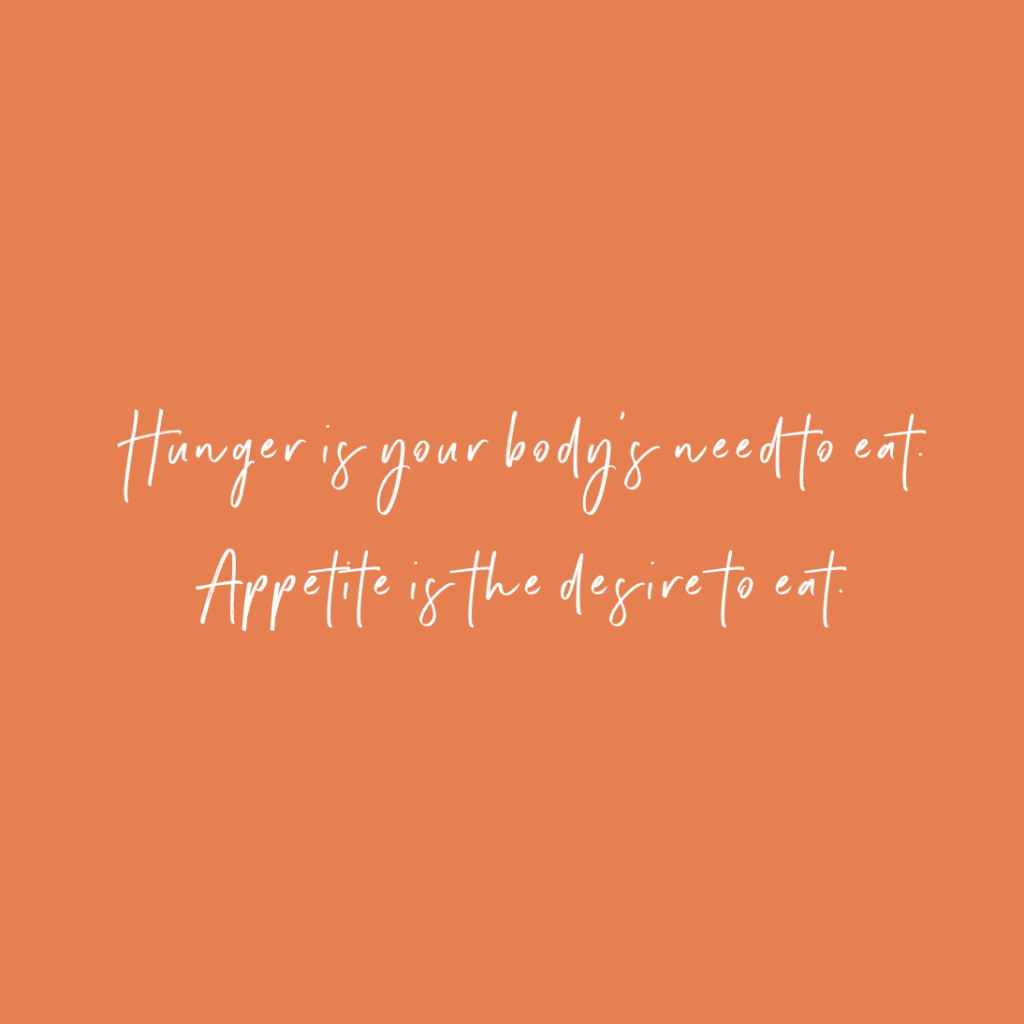
There are many things that can be mistaken for hunger. Your ability to detect hunger and fullness gets clouded by other influences; a primary influence is emotions. Any emotion under the sun can mask your sense of hunger. Stress is a term possibly used to describe ANY uncomfortable feeling. More specific words to describe stress might be anxiety, worry, sadness, anticipation, restlessness, frustration and loneliness. When any of these stressful emotions come up it can make you feel hungry when you are not.
Happy emotions can be confused with hunger too: excitement, anticipation, joy and love. All these emotions happen at your core. They catch you in your gut. That’s where you feel them.
The ability to detect physical hunger and fullness can get blocked by any emotion, even happy, positive emotions. You feel the sensation of emotion in the center of your body, the same place you feel physical hunger.37
It is not just emotions that get in the way of detecting hunger and fullness. There are external triggers in your surrounding environment that make you believe you are hungry. Seeing and smelling food, especially yummy favorites, can make you think you are hungry. Really, what has increased is your appetite, not your physical hunger.14,32,38-40
Hunger is your body’s need to eat, a compelling need for food.14 If you’re hungry, you need food because your body is telling you so by sending you signals. These signals can be painful, annoying and sometimes rumbling sensations, or a weakness you feel over your entire body. Hunger cannot be dictated; it is instinctive.41
Appetite is the desire to eat, a fondness for or liking a particular food. Appetite is a coordinated effort between your brain and your stomach.14 When you see a food that looks particularly tasty, your mouth may water. When this happens you can practically taste it and feel the textures in your mouth.
Even thinking about food can elicit the same response. But unlike hunger, appetite can be controlled. Your brain greatly influences appetite levels and your response to it. It is a learned behavior.13-14 I know, now your brain is saying, “What???????” It’s a little mind-blowing.
We CAN learn to control and change the level of our appetite. It takes practice to understand what triggers your appetite and what contributes to your hunger being confused by emotions.
Wanting a food, versus needing it, is a craving. Cravings are usually driven by appetite, very often an external cue. You want or crave a food after seeing it or thinking about it. Being at the checkout counter at Home Depot and seeing your favorite treat and wanting it as you buy duct tape is an external cue, not an internal cue (physical hunger).13-14,40
There are millions of external cues. Television commercials are a prime example.14,39 That luscious, dripping burger that you weren’t thinking of five minutes earlier, suddenly sounds pretty tasty. Part of this process, the work and commitment part, will require distinguishing physical hunger (an internal cue) from other appetite triggers (external cues).14,38,42
References
13. Murray M, Vickers Z. Consumer views of hunger and fullness. A qualitative approach. Appetite. 2009;53(2):174-182.
14. Rebello C, Greenway F. Reward-Induced Eating: Therapeutic Approaches to Addressing Food Cravings. Adv Ther. 2016;33(11):1853-1866.
32. Stroebe W, van Koningsbruggen G, Papies E, Aarts H. Why most dieters fail but some succeed: A goal conflict model of eating behavior. Psychol Rev. 2013;120(1):110-138.
37. Komaroff A. The gut-brain connection. Harvard Health Publishing website.
38. Loxton N, Dawe S, Cahill A. Does negative mood drive the urge to eat? The contribution of negative mood, exposure to food cues and eating style. Appetite. 2011;56(2):368-374.
39. Spence C, Okajima K, Cheok A, Petit O, Michel C. Eating with our eyes: From visual hunger to digital satiation. Brain Cogn. 2016;110:53-63.
40. Kroemer N, Krebs L, Kobiella A et al. (Still) longing for food: Insulin reactivity modulates response to food pictures. Hum Brain Mapp. 2012;34(10):2367-2380.
41. Cohen, D. Under the radar: What made you buy (and eat) that. Nutrition Action. 2016; March.
42. Vartanian L, Spanos S, Herman C, Polivy J. Conflicting internal and external eating cues: Impact on food intake and attributions. Health Psychol. 2017;36(4):365-369.

Comments are closed.